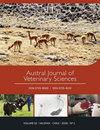Prevalence, risk factors, and identification of Salmonella spp. in stray dogs of northwest Mexico
IF 0.8
4区 农林科学
Q3 VETERINARY SCIENCES
引用次数: 3
Abstract
Salmonellosis has a worldwide relevance in aspects associated with public health, as only in 2009 were reported 93.8 million cases in humans. The objective of the study was to establish the prevalence, risk factors and bacteriological and molecular identification of Salmonella spp in stray dogs in urban, rural and coastal areas of Mexicali, a city in northwest Mexico. From May 2014 to February 2015, 385 dogs were tested. Sampling was performed by rectal swab and conventional bacteriological techniques were applied, for later implementation of the API 20E system and molecular identification by polymerase chain reaction (PCR). The data were analysed statistically by means of descriptive statistics and multiple logistic regression modelling. A prevalence of 6.27% was obtained in the dogs examined, the samples obtained were characterised to subspecies ( Salmonella enterica subspecies enterica and Salmonella enterica subspecie arizonae ). The geographical region with the highest prevalence in the study was the coast (10%), followed by the rural area (8.57%) and the urban area (5.8%), however, no significant statistical differences were detected. There was significant difference in the prevalence by age of dogs under one year ( P <0.05). The identification of Salmonella in dogs from northwest Mexico could correspond to serovars of zoonotic importance indicating a potential risk for the population. Key words : Salmonella spp, prevalence, stray dogs, public health.墨西哥西北部流浪狗中沙门氏菌的流行、危险因素和鉴定
沙门氏菌病在与公共卫生有关的方面具有世界范围的相关性,仅在2009年就报告了9380万例人间病例。本研究旨在了解墨西哥西北部墨西卡利市城市、农村和沿海地区流浪狗中沙门氏菌的流行情况、危险因素及细菌学和分子鉴定。2014年5月至2015年2月共检测385只犬。采用直肠拭子取样,采用常规细菌学技术,随后采用API 20E系统和聚合酶链反应(PCR)进行分子鉴定。采用描述性统计和多元逻辑回归模型对数据进行统计学分析。检出率为6.27%,检出率以亚种(肠道沙门菌亚种和亚利桑那肠道沙门菌亚种)为主。研究中患病率最高的地理区域为沿海地区(10%),其次为农村地区(8.57%)和城市地区(5.8%),但没有发现显著的统计学差异。不同年龄1岁以下犬的患病率差异有统计学意义(P <0.05)。在墨西哥西北部的狗身上发现的沙门氏菌可能对应于具有人畜共患病重要性的血清型,表明对人群存在潜在风险。关键词:沙门氏菌;流行;流浪狗;
本文章由计算机程序翻译,如有差异,请以英文原文为准。
求助全文
约1分钟内获得全文
求助全文
来源期刊

Austral Journal of Veterinary Sciences
Veterinary-General Veterinary
CiteScore
1.60
自引率
0.00%
发文量
18
期刊介绍:
Austral Journal of Veterinary Sciences (formerly Archivos de Medicina Veterinaria) publishes original scientific contributions in English, containing the latest developments and discoveries in veterinary sciences. The journal covers topics such as animal health and production, preventive medicine, zoonosis, pharmacology and therapeutics, methods of diagnosis, and other areas related to the veterinary field.
Austral Journal of Veterinary Sciences aims to divulge information about advances in veterinary medicine among universities, research centres, industries, government agencies, biologists, agronomists and veterinarians.
 求助内容:
求助内容: 应助结果提醒方式:
应助结果提醒方式:


